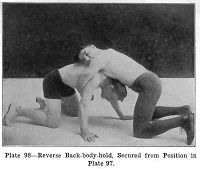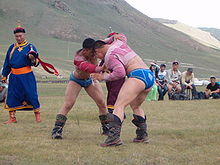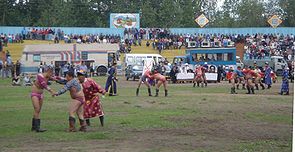- Folk wrestling
-
Folk wrestling 
Focus Submission A folk wrestling style is a traditional wrestling discipline which may or may not be codified as a modern sport. Most human cultures have developed their own sort of grappling style unique from other styles practiced. While many styles in the Western culture may have their roots in Ancient Greece other styles, particularly those from Asia, developed independently.
Contents
List of folk wrestling styles
Europe
British Isles
Traditionally wrestling has two main centers in Great Britain: the West Country, where the Devonshire and Cornwall styles were developed, and in the Northern counties, the home of the Cumberland and Westmorland styles.
North Country styles
- Lancashire wrestling is a historic wrestling style from Lancashire in England known for its "Catch-as-catch-can", or no wrestling holds barred, style.
- Catch wrestling, or Catch-as-catch-can, originated from Lancashire wrestling but was further developed during the traveling circus phenomenon of the 19th and early 20th century United States.
- Backhold Wrestling, whose origin is unknown, was practiced in North England and Scotland in the 7th and 8th century but competitions are held in present day at the Highland and Border Games as well as in France and Italy. Styles of Backhold are distinct from Lancashire Wrestling because they enforce rules designed to minimize injury to the participants by disallowing ground fighting.
- Cumberland and Westmorland wrestling, or Cumbrian Wrestling, is practiced in the northern counties of England. It is a form of Backhold Wrestling where the wrestlers put the left arm over the opponents right arm and grip behind the opponent's back. Throws and trips are important since the first wrestler to touch the ground or break hold loses. Competitors often wear stockings (long johns), singlet and trunks.
- Scottish Backhold is a form of Backhold practiced in Scotland. Almost identical in style to Cumberland & Westmorland style apart from variations in rules. Competitors often wear kilts.
West Country styles
- Cornish wrestling, from Cornwall, is a form of jacket wrestling. It does not use groundwork. It is related to Breton Gouren wrestling.
- Devon wrestling, or Devonshire wrestling, was a style similar to the Cornish style in that jackets were worn. Devonshire wrestlers, however, also wore heavy clogs and were able to kick the opponents. In Cornish vs Devon matches the Devonshire wrestlers might have worn one only shoe. Unlike, Cornish wrestling, the style is generally considered to be extinct.
Ireland
- Collar-and-elbow wrestling is native to Ireland and can be traced back to the 17th century but it has ties to the Tailteann Games between 632 BC and 1169 AD.
Nordic countries
- Glíma, the national sport of Iceland, traces its history to the Vikings and the Norse. It is a standing style with rules similar to Shuai-Jiao and Bukh, and consists of three forms: 1) Hryggspennu-tök, the Backhold Grip; 2) Brokar-tök or the Pant-and-belt Grip that utilises a leather harness around the waist and thighs, which the wrestlers hold (making it a form of belt-wrestling similar to Swiss Schwingen), and 3)Lausa-tök or Free Gripping. It is often practised outdoor or indoors on a wooden floor, hence hard throws are often discouraged.
Continental Europe
- Chidaoba - traditional Georgian jacket wrestling
- Lotta Campidanesa from Italy - Sardinian collar, jacket and belt wrestling practised by countrymen and shepherds in southern Sardinia
- Lucha Canaria, or Canarian wrestling, native to the Canary Islands in Spain, touching ground (non-foot) loses
- Lucha Leonesa, native to the Spanish region of León, touching ground (non-foot) loses
- Rangeln, meaning "to wrangle" in German, is a prominent form of wrestling in Austria, where the winner is the man who pins his opponents to the ground
- Schwingen is the Swiss style of wrestling considered to be one of the oldest forms of wrestling. Wrestlers wear special canvas trousers
- Trântă: Upright wrestling from Moldova; it can also be practised from the knees. It is still practised in Moldova and eastern Romania
- Narodno rvanje, is a wrestling style from Serbia, In Narodno Rvanje there are three disciplines, depending on the hold, they can be chest hold, belt hold or back hold.
Asia
Near East and Central Asia
- Iranian Wrestling or Koshti. Includes the Iran-wide Pahlavani, and numerous other provincial styles.
- Karakucak. Rules are similar to Olympic freestyle wrestling. Wrestlers are not oiled.
- Oil wrestling. Wrestlers wear special leather trousers 'kispet' and are oiled.
- Gulesh, a Azerbaijani wrestling style
- Kokh is a traditional Armenian style of wrestling
- Kurash - traditional Tuvan jacket wrestling of the ethnically Turkic region of Tuva, in southern Siberia.
- Küres - traditional Kazakh jacket wrestling, touching ground (non-foot) loses. Leg grabs are not allowed, but a wrestler may trip the legs.
South Asia
Main article: Indian wrestling- Malla-yuddha, traditional styles extant in South India
Southeast Asia
- Khmer Traditional Wrestling is a folk wrestling style from Cambodia.
- Penjang Gulat is a form of wrestling popular in rural Indonesia.
East Asia
- Shuai Jiao 摔跤: Chinese jacket wrestling originating from Beijing, Tianjin and Baoding in Northern Hebei which means "Throw and Trip (at the ankle)". Also known as Guan Jiao 摜跤 and Liao Jiao 撩跤, meaning "Continuing Trip (at the ankle)" and "Hold-up and Trip (at the ankle)". In Qing Dynasty time it was also known as "Buku (布庫)", Manchu word for wrestling which has the root as Mongol word Boke. This style of wrestling was the style of Martial Art practised by Imperial Guard in Liao, Jin, Yuan, Ming and Qing Dynasties. The present techniques were codified by Emperor Kangxi in the 1670s. Traditionally wrestlers wear jacket called "Da Lian (搭褳)" and chaps over their pants, which allow grapping on the chaps for lifting. In addition, Qin Na techniques such as arm bar were allowed in Beijing, and striking and blocking using upper arms were allowed in Tianjin. Rules have since incorporated Shanxi Die Jiao and modern Olympic Wrestlings.
- Boke 搏克: Chinese jacket wrestling from Inner Mongolia that wear jacket made of cow leather, long pants with chaps over and boots. Rules and techniques are more similar to Shuai Jiao than to Boke practised in Mongolia Republic, where wrestlers wear only short, tight, collarless, heavy-duty short-sleeved jacket and small, tight-fitting briefs made of red or blue colored cotton cloth.
- Die Jiao 跌跤: Chinese wrestling from Xinzhou (忻州), Northern Shanxi (山西) Province. Competitors wear only pants, and no jacket nor belt nor boots are to be worn. Main techniques are the "48 Leg Takedowns" which were first codified in Song Dynasty around 1180's. This form of wrestling was popular throughout Northern China as recorded in history books, until the spread of Shuai Jiao, which is considered more advanced as the grappling and tripping techniques. It was colloquially known as "Mo Ni Qiu (摸泥鳅)", literraly grapping the mud Qiu, a kind of catfish in Northern China.
- Qielixi 切里西: Chinese belt wrestling practised by Uyghur Nationality.
- Gi Ge 几格: Chinese belt wrestling practised by Yi Nationality (彝族) in Sichuan (四川) and Yunnan (雲南). "Gi Ge" literally means "Holding Waist". The three main rules are: no tripping using legs; no grapping on jacket or pants; no pushing or striking. Rules have now been changed to allow holding of legs.
- Ndrual Dluad: Chinese wrestling practised by Miao/Hmong Nationality throughout Southwestern China. A belt wrestling style, competitors can weat traditional dress or modern dress but they must hold on to the belt at all time.
- Beiga 北嘎: Chinese belt wrestling practised by Tibetan. Also known as "Jiazhe (加哲)" and "Youri (有日)" in Tibet,"Xiezhe (寫澤)" in Western Sichuan, and "Jiareze (卡惹則)" in Qinghai. It is a belt wrestling, and wrestlers compete barefoot and must grap the belt at all time. No tripping is allowed. This rule is dated back to the 7th century. With the ruling of Mongols, Han and Manchu since the 13th century, leg trippings are introduced and hence there are 2 distinct forms.
- Tegumi is the folk wrestling practiced in Okinawa.
Americas
- Luta Livre, Brazilian style of wrestling.
- Lucha Libre, Mexican style of wrestling.
Africa
- Lutte Traditionnelle, (fr. for Traditional Wrestling) related styles of West African wrestling, known as Laamb in Senegal, Boreh in The Gambia, Evala in Togo, and Lutte Traditionnelle in Niger and Burkina Faso. International competition takes place during the Jeux de la Francophonie and the newly organised Championnat d'Afrique de lutte traditionnelle.
Oceania
- Coreeda, a modern synthesis that combines traditional Aboriginal dance, mainly in the form of kangaroo mimicry, with a style of wrestling performed around a yellow 4.5m diameter circle with black and red borders similar to the Aboriginal flag. Competitors wear knee length pants, a wide sash belt and a jersey that can be grabbed to assist in throws. It is based on similar games that were played in pre-colonial Australia and is usually performed during NAIDOC in the Western Suburbs of Sydney. Extinct indigenous Australian styles include turdererin from Southern Victoria, partambelin from Southern NSW, goombooboodoo from Western NSW, ami from Southern QLD and donaman/arungga from Northern QLD.
- Epoo korio, a friendly style of wrestling done on Kiwai Island in the Fly River Delta of Western Province of Papua New Guinea, involved one wrestler who had to defend a small mound of sand which his opponent was trying to destroy.
- Boumwane, the national style of Kiribati with a simple toppling victory performed during National Day celebrations, a similar sport is also played in Nauru.
- Dumog, the indigenous style of the Visayan Islands of the Philippine archipelago, was performed on sandy beaches during rice harvest celebrations in pre-colonial times but is now done during the town saint's festivals. Opponents wore a colourful patterned bahag (loincloth) in the past to indicate which village he was from and were covered in tattoos and amulets to gain assistance from the spirit world. The object was to throw the opponent so that his back touched the ground, if he had to brush the sand off his back this was considered a loss. On the verge of extinction it can only be seen on rare occasions in the remote parts of Panay, Cebu and Negros.
- Fagatua, the indigenous style of Tokelau used mainly to settle regional disputes between villages.
- Hokoko, the indigenous style of the Kanaka Maoli of the Hawaii Islands, first recorded by crew members during the HMS Resolution's 1779 visit to the main island as part of the pa'ani'kahiko or 'ancient games', performed during the Makahiki New Year Festival. Along with mokomoko boxing it is a core skill of the bone breaking martial art of lua.
- Mamau/ringa ringa, the indigenous style of the Maori of New Zealand, mainly used for warrior training but now occasionally being performed as part of the Matariki New Year Festivals as a recreational activity.
- Mariwariwosu, the indigenous style of the Formosan Aboriginal people of Taiwan such as the Paiwan and Bunun tribes. Performed on a circular sandpit with competitors grabbing hold of their opponents large waist belts before the start of the match it involves many skillful throws and is an important part of the National Aboriginal Games.
- Moana, the indigenous style of the Ma'ohi of Tahiti and French Polynesia; along with teka (spear throwing), motora'a (boxing) and amoraa ofae (heavy stone lifting) will be included as part of the Heiva i Tahiti or traditional sports festival held in Papeete every July. A similar sport is also played in the Cook Islands during the Te Maeva Nui national day celebrations.
- Pi'i tauva, the indigenous style of the Kingdom of Tonga was first seen by Europeans in 1777 in which the artist John Webber recorded in lithograph. It combined boxing and wrestling, being performed as entertainment for visitors by both men and women.
- Taupiga, the indigenous style of the Samoan Islands saw the wrestlers greased up with coconut oil before competitions (similar to Turkish yagli gures) and was an important part of the inter-village gatherings.
- Uma, also known as Kulakula'i, is a hand-wrestling game practiced by the indigenous residents of Hawaii. The contestants kneel and grasp each others' elbows on the same side. The object is to force one's opponent's arm to the ground.[2] The game was frequently played by the Hawaiian ruling class (the Ali'i).[3]
- Veibo, the indigenous style of Fiji was mainly used as a method of warrior training but also occasionally as a form of entertainment. In the early 20th century, indentured labourers were brought from India to work the cane fields and their style of wrestling, kushti, was fused with veibo to create a hybrid style similar to freestyle wrestling.
Martial arts originating from folk wrestling styles
These sports could be considered too popular or formal to still be considered "folk sports". These styles form a part of international mainstream wrestling.
- Luta Livre Esportiva, Luta Livre Vale Tudo, which emphasises ground fighting and submissions.
- Shuai jiao, the jacket wrestling folkstyle of Northern China which includes Qiaoshou (literally translated: striking hands) and Chin Na in trainings but disallowed in competition. A standup style.
- Brazilian Jiu-Jitsu, which emphasises ground fighting and submissions from kodokan judo.
- Collegiate wrestling, the folkstyle of the United States.
- Greco-Roman wrestling, now a major international style and Olympic sport.
- Kodokan Judo, founded by Jigoro Kano in 1882, currently an Olympic sport.
- Sambo, a Russian jacket wrestling style based on various forms of folk wrestling in the former USSR and Judo.
- Shoot wrestling, a Japanese style primarily based on catch wrestling.
- Sumo, a famous Japanese wrestling style.
Footnotes
- ^ The Alternative Olympics by Ron Gluckman (Mongolia)
- ^ David Malo (1903). Hawaiian antiquities (Moolelo Hawaii). Hawaiian gazette co., ltd.. p. 96. http://books.google.com/books?id=5cjaw4b3HoUC&pg=PA96. Retrieved 6 October 2011.
- ^ "Coral Reef and Assessment Monitoring Program". University of Hawaii. http://cramp.wcc.hawaii.edu/LT_Montoring_files/lt_study_sites_Oahu_Hanauma_Bay.htm. Retrieved 2011-10-06.
Sources
- The Wrestler's Body: Identity and Ideology in North India by Joseph S. Alter (1992). ISBN 0-520-07697-4
External links
- A Brief History of Wrestling in England
- History of Sports in Ancient Egypt
- "Wrestling in Ancient Nubia" by Scott T. Carroll, Journal of Sport History', Vol. 15, No. 2 (Summer, 1988)
- Lucha Canaria
- Lucha Leonesa
- Folk Style Wrestling
Grappling · Submission wrestling · FILA · History of wrestling · List of martial arts Categories:- Folk wrestling styles
- Lancashire wrestling is a historic wrestling style from Lancashire in England known for its "Catch-as-catch-can", or no wrestling holds barred, style.
Wikimedia Foundation. 2010.



